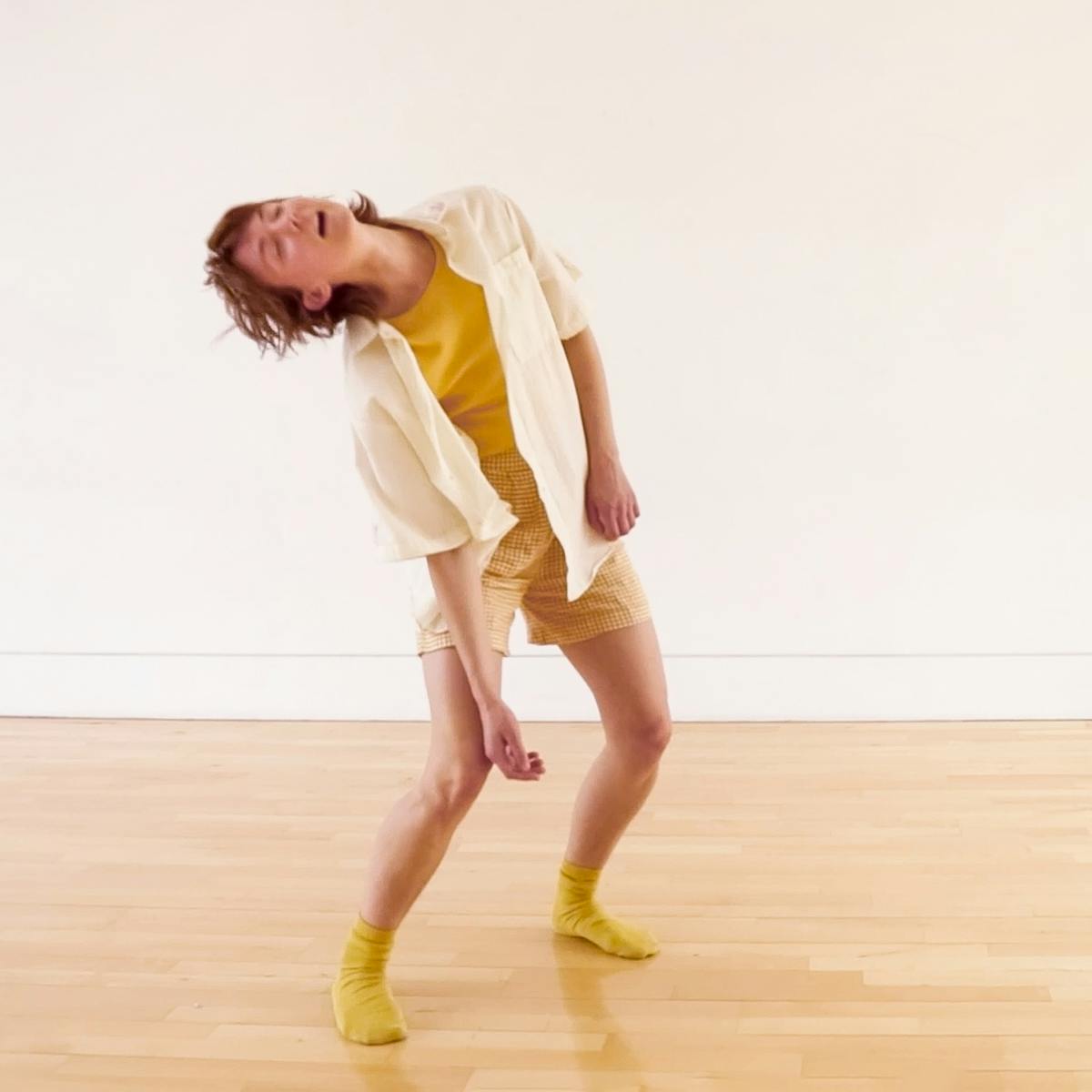When a formal diagnosis confirmed that they were neurodivergent, Susanna Dye became increasingly curious about how their need for self-regulatory, repetitive movement could intersect with their chosen field of expertise – dance. There they discovered a space where dancing itself became stimming.

Do you ever catch yourself rocking, tapping or pacing? Maybe there is a way you love to trail your fingers over your scalp, or a rhythmic movement you fall into when you are deep in thought or feeling anxious. As you read this, you may notice some tangential movements happening in your body that are helping you to stay focused. These movements are known as stimming.
Short for self-stimulatory movements, stimming is the rhythmic, repetitive movement we do to self-regulate, helping us to manage our emotions and to process sensory input from our environment. Although stimming is a universal part of human behaviour, it is particularly important for neurodivergent people, who experience differences in how we process information and sensory input.
The best example of my childhood stimming was an activity my family aptly named ‘Thinking in Fiddle’. I had a jar of beads, and I would regularly take myself off, pour the beads out, and meditatively trail my fingers through them, often while rocking and softly murmuring out loud
Sometimes I would be making up stories and imagining worlds, or I would simply be processing what had happened during the day. I couldn’t do this kind of thinking through without the rhythmic movement as an underscore. I remember ‘Thinking in Fiddle’ being a safe and soothing space I could retreat to when I was feeling overwhelmed, often during social situations like family gatherings.
Rocking. Video captured during STIMMING R&D. 2021. Featuring Susanne Dye.
Although my family and I could recognise my need for it, I felt ashamed, sensing that it was antisocial to sneak away from other people to seek comfort in my beads. It wasn’t something that my friends did, and the older I became, the more embarrassed I felt, so I began to suppress it.
The sensory need to self-soothe
My recent interest in stimming came out of my paradoxical relationship with dance, and my discovery of my neurodivergence as an adult. Growing up, I was an intuitive dancer, trailing a path of whirling, waving and kicking limbs through our small downstairs flat. Yet the way dance classes are structured left me feeling like dance was not for me.
I experience difficulties with memorising sequences, reproducing movements performed by others, and coordinating my body in time and space. I felt like everyone else in the room had a superhuman ability to keep up with the class, while I got stuck and trailed behind.
My self-consciousness about my stimming makes me curious to observe other people’s movement habits and empathise with them.
In adulthood, finding out that I am dyspraxic and dyslexic has helped me to make sense of the frustration I experienced then. At the time of my diagnosis, I was, perhaps surprisingly, tentatively finding my way into the professional world of dance. Having opted out of mainstream dance training due to my early struggles, it dawned on me that I could continue striving to follow normative practices, but only at great physical and emotional cost.
Instead, I shifted my focus towards ways of moving that my body already knew, asking myself, “Which ways of moving feel good to me?”
Poppet Play. Video captured during STIMMING R&D. 2021. Featuring Danni Spooner.
Learning about stimming led me to reflect on my resistance to sitting still, and my preference for the floor rather than sitting on a chair or at a desk. Because I need more sensory input to feel stable, I find myself hugging a knee into my chest, rocking, pressing into my feet and finding stretches and twisting postures that offer muscular feedback or tension. These movements enable me to feel grounded: to locate myself in what can feel like a void.
At times, I have been made to feel aware that my sensory-seeking movements are irritating or uncomfortable for others, and disrupt the social norms and etiquettes of different spaces. As such, my self-consciousness about my stimming makes me curious to observe other people’s movement habits and empathise with them. I enjoy knowing how soothing certain movements can feel, and am interested in what kinds of feelings or thoughts people might be processing through them.
This curiosity has been amplified as I begin to connect with communities of neurodivergent and disabled artists on my own journey of becoming an artist and facilitator. I can recognise our greater need for stimming, and how tuning in to other people’s stimming movements can be a way to connect and share understanding.
This has led me to question the space between stimming and dance.

Left: A shared plane of experience. Photograph. 2021. Featuring Danni Spooner and Susanna Dye. Right: Swinging spines. Photograph. 2021. Featuring Aby Watson and Susanna Dye.
Switching focus
To dive deeper, I invited two neurodivergent dance artists, Aby Watson and Danni Spooner, to explore how our approach to dance could be guided by our stimming bodies. We embraced rhythm and repetition, which helped us to experience a sense of release and find flow.
Questioning the need for dance to be virtuosic, we embraced what felt good rather than what looked good to an outside eye. By working with improvisation, we could move in response to sensory input, shifting between outward and inward focus.
As such, the dancing itself became stimming: a way of moving that was responding to our need for sensory stimulation and self-regulation.
“I would be performing the stim, not really actually doing it, and then I would go into doing it for real, and then noticing how clear my head would be, and noticing my face relaxing as it became an actual, real thing, not a task I set myself,” Danni says.
Rhythmic dialogues. Video captured during STIMMING R&D. 2021. Featuring Danni Spooner and Susanna Dye.
We were excited to discover new ways of relating to each other that felt comfortable and playful: responding to each other’s sounds, movements and rhythms, and sharing each other’s sensory experiences.
Bringing stimming into my creative practice has revealed to me how I experience these rhythmic, repetitive movements as a liminal space between thinking and feeling, between passively receiving and actively seeking out. It is a space for listening and processing, a space for losing and finding myself in sensation: a space of rest and of play.
Through exploring stimming, I have gained a greater acceptance of, and trust in my body. I’ve learned about how self-care is a process of deep listening, and have discovered the joy in yielding to my impulses for movement, rather than suppressing them. Identifying what stimulates my movement has enabled me to take pleasure in my physical interactions with the world and the people who share it with me.
As I shed light on stimming through my artistic work, I want to create space for people to resonate and empathise with ways of being that are considered ‘other’, and to acknowledge how our environments, attitudes and the systems we navigate are what disables us.
About the contributors
Susanna Dye
Susanna works between the fields of theatre, dance and film, exploring how movement and the body are encountered both live and digitally. Susanna is exploring how developing an approach to dance guided by sensory experience dismantles the access barriers they experience as a neurodivergent artist. As part of this enquiry, Susanna is exploring habitual movement patterns and how the body self-regulates through movement. This research has been awarded funding by Arts Council England, and is supported through residencies at The Place, Wellcome Collection and Siobhan Davies Studios. Susanna’s collaboration with Manon Ouimet, Danni Spooner and Aby Watson can be seen in the virtual STIMMING space.
Manon Ouimet
Manon Ouimet is a London-based, award-winning photographer. In 2019, she received a distinction for her MA in Photography at the University of the West of England, Bristol. Manon engages with notions of identity and the therapeutic values photography can offer, posing difficult yet essential questions regarding body image and visual representation.

